NOx Reduction in Ag/Al2O3-SiO2 Converters in the Exhaust of a Compression-Ignition Engine
Abstract
:1. Introduction
- Engine-internal methods. These methods consist in conducting the processes taking place during the preparation and then the combustion of the mixture [4] in such a manner as to make sure that NOx concentration levels in the engine exhaust gas are as low as possible. The process consists in finding the optimum balance between the power developed by the engine, unit fuel consumption and the emission of harmful substances,
- The use of catalytic converters designed to reduce nitrogen oxides [1], including NH3-SCR and possibly HC-SCR converters.
- The following methods are commonly used in parallel to reduce NOx emissions:
- Exhaust gas recirculation (EGR), which lowers [5] the production of NOx in the engine’s cylinder, and
- Reduction with ammonia (NH3-SCR)
- Reduction with hydrocarbons (HC-SCR), or their derivatives containing oxygen, light alcohols in most cases. These converters have the characteristic qualities:
- ○
- Achieve [16] relative low NOX conversion rate,
- ○
- NOX conversions are achieved [16] only in a narrow range of high temperatures,
- ○
- they require high doses of hydrocarbons due to their low selectivity, which contributes to higher converter temperatures [16,17]. It is often observed that the higher the dose of injected hydrocarbons, the wider the NOX reduction temperature range, yet a high dose of injected hydrocarbons may cause an increase in the temperature of the converter to levels that are uncommon for oxidising converters used in compression-ignition engines. An injection of 3% of the fuel dose upstream of the HC-SCR converter causes an increase in the temperature of the converter’s bed by 30 °C, while a 6% fuel injection increases the temperature by 50 °C.
2. Preparation of Ag/Al2O3-SiO2 Converters
- A substrate in the form of a steel foil monolith,
- A foundation layer made of aluminium polyphosphate,
- A catalytic carrier being a mixture of al2o3 and sio2 oxides,
- Catalytically active silver applied onto the carrier.
- Al2O3-SiO2 converter-carrier—the intermediate layer with Al2O3-SiO2 carrier applied onto the steel foil monolith,
- IAg/Al2O3-SiO2 converter—the carrier was impregnated with silver nitrate solution, which was used to coat the sample with the Al2O3-SiO2 carrier applied onto the steel foil monolith in order to achieve a silver content of 2 g/dm3,
- IIAg/Al2O3-SiO2 converter—also in this case the carrier was impregnated with a silver nitrate solution and the silver content achieved was 4 g/dm3.
- Steel foil plates covered with the Al2O3-SiO2 carrier without aluminium polyphosphate base.
- Steel foil plates covered with the Al2O3-SiO2 carrier without an aluminium polyphosphate base, impregnated with a nitrate solution, obtaining a silver content of 4 g/dm3.
3. Research Part
- Evaluation of the physicochemical properties, significant for the catalytic activity, of the Al2O3-SiO2 carrier surfaces and the Ag/Al2O3-SiO2 silver coated carrier, by examining the structure, porosity and acidity of the carrier surface and examining the degree of silver dispersion;
- Proving the catalytic activity of the catalytic support Al2O3-SiO2;
- Evaluation of the catalytic activity of a converter with various silver loads;
- Determination of the reduction ratio of NO2 and NO on the reducing catalytic converter depending on the conversion temperature and the addition of reducing agent in the form of propane.
- Stage 1
- NOx conversion tests on the Al2O3-SiO2 carrier-reactor and the IAg/Al2O3-SiO2 and IIAg/Al2O3-SiO2 reactors depending on the temperature of the catalytic process with a constant dose of the reducer placed in an electric tubular furnace enabling setting the temperature of reactor models up to 700 °C with actual diesel engine exhaust gases flow.
- Stage 2
- Testing the acidity of the surface of the carrier in the form of a powder isolated from a steel foil coated with an Al2O3-SiO2 carrier without an aluminum polyphosphate base, using ammonia desorption method.
- Stage 3
- Measurements of the specific surface area and porosity of a catalytic support in the form of a powder isolated from a steel foil coated with an Al2O3-SiO2 support without an aluminum polyphosphate base: specific BET surface,
- volume and surface of mesopores distribution by the BJH method,
- volume and surface of micropore distribution by the DFT method.
- Stage 4
- Tests of silver dispersion on IIAg/Al2O3-SiO2 powder isolated from a coated steel foil without an aluminum polyphosphate base, by the method:
- oxygen adsorption on silver crystallites,
- analysis of the images from the transmission electron microscope.
- Stage 5
- Tests of NO, NO2 and C3H8 conversions and propane selectivity in the reduction of NO to N2 of the IIAg/Al2O3-SiO2 converter model placed in an electric tubular furnace depending on the NOx conversion temperature at a constant dose of the reducer (C3H8) and depending on the dose of the reducer at a constant NOx conversion temperature.
3.1. Comparative Studies of NOx Conversion in a Carrier-Converter and Silver-Impregnated Converters
3.2. Tests of Acidity of the Surface of the Al2O3-SiO2 Carrier
- 3 min at approx. 100 °C (372 K),
- sample heating at the rate of 12 degrees/minute up to approx. 420 °C (692 K),
- heat treatment of the sample for 30 min until the signal from ammonia disappears.
3.3. Studies of the Specific Surface Area and Porosity of the Catalytic Support
3.3.1. Tests of Distribution of Volume and Surface of Mesopores of the Catalytic Carrier
3.3.2. Tests on the Distribution of Volume and Surface of Micropores of the Catalytic Carrier
3.4. Tests of Silver Dispersion on IIAg/Al2O3-SiO2 Powder Isolated from a Steel Foil Coated without an Aluminium Polyphosphate Base
Oxygen Absorption on Silver Crystallites Method
- Oxidation of the sample with oxygen doses at 500 °C,
- The elimination of oxygen from the sample in a stream of helium,
- Supplying several 109 mm3 doses of oxygen in a stream of helium with a flow rate of 30 cm3/min every 90 s at 170 °C.
3.5. Method of Analyzing Images from the Transmission Electron Microscope
3.6. Tests of Catalytic Activity of a Silver-Impregnated Carrier
4. Discussion
- (1)
- The catalytic Al2O3-SiO2 support developed is a good basis for depositing dispersed silver, because it is characterized by a large specific surface (BET surface equal to about 195 g/dm3) and an extensive network of meso and micropores, as well as surface acidity exceeding by 8% the values of aluminosilicates. This support is active in reducing nitrogen oxides, achieving a maximum conversion of 70% at the temperature of 450 °C.
- (2)
- Silver crystallites applied by impregnation method have dimensions in the order of 7–12 nm and they are comparable with the dimensions of platinum crystallites in the TWC converters.
- (3)
- In the course of the experiment, an approx. 90% reduction of nitrogen oxides was achieved for the silver-based catalytic converter. Unfortunately, the catalytic properties occur at relatively high temperatures (T > 400 °C), but within a rather wide range of temperatures. Above 500 °C, a drop in the rate of reduction of nitrogen oxides is observed, which is insignificant in the case of exhaust gases produced by compression-ignition engines. Unfortunately, the selectivity of propane in the process of NOx reduction is low and does not exceed 20%, which makes it necessary to supply the reducer in high concentrations.
- (4)
- The reduction of nitrogen oxides is a two-stage process. In the first stage, NO2 is reduced at a temperature of approx. 200 °C; in the second stage, NO is reduced to N2 at a temperature ranging from 200 to 550 °C.
- (5)
- The activity of the IIAg/Al2O3-SiO2 catalytic converter, measured using the conversion rate of NOX, was examined at relatively low values of the relative volume velocity of the exhaust gas flow of 14,000 h−1. NOx conversion at higher SV values is still to be investigated; the same applies to the construction of a complete catalytic converter with a relatively large volume, which could be fitted into an actual petrol engine.
- (6)
- Replacement of the PGM group metals with silver may contribute to a significant reduction in production costs of this type of reactors. Thus, for 1 dm3 of DOC volume containing usually 1g/dm3 of platinum, the cost of precious metal is about $34, while the corresponding cost of silver in the amount of 4g/dm3 is about $3.2, which means that it is about 10 times smaller.
Author Contributions
Funding
Institutional Review Board Statement
Informed Consent Statement
Data Availability Statement
Conflicts of Interest
Symbols
| φ | the angle of wetting for the meniscus of the liquid in relation to the wall of the capillary [º] |
| δ | surface tension of the liquid [N/m] |
| C | silver content of the sample [% of the mass] |
| c(C3)k | propane concentration downstream of the catalytic converter |
| c(C3)p | propane concentration upstream of the catalytic converter |
| c(NO)k | NO concentration downstream of the catalytic converter |
| c(NO)p | NO concentration upstream of the catalytic converter |
| L20 | average diameter of crystallites of silver [nm] |
| p | vapour pressure over a flat surface [Pa] |
| po | vapour pressure above a curved (cylindrical) surface [Pa] |
| R | universal gas constant [J/(mol · K)] |
| s(C3/NO) | selectivity of propane in the nitrogen reduction process |
| T | temperature [K] |
| Vm | liquid volume [mol] |
References
- Kruczyński, S.W.; Merkisz, J.; Ślęzak, M. Zanieczyszczenia Powietrza Spalinami Przez Transport Samochodowy; Wydawnictwo WKiŁ: Warszawa, Poland, 2019. (In Polish) [Google Scholar]
- Puchalski, A.; Komorska, I.; Ślęzak, M.; Niewczas, A. Synthesis of naturalistic vehicle driving cycles using the Markov Chain Monte Carlo method. Eksploat. Niezawodn. 2020, 22. [Google Scholar] [CrossRef]
- Wiśniowski, P.; Ślęzak, M.; Niewczas, A.; Szczepański, T. Method for synthesizing the laboratory exhaust emission test from car engines based on road tests. IOP Conf. Ser. Mater. Sci. Eng. 2018, 421, 042080. [Google Scholar] [CrossRef]
- Zamboni, G.; Moggia, S.; Capobianco, M. Effects of a dual-loop exhaust gas recirculation system and variable nozzle turbine control on the operating parameters of an automotive diesel engine. Energies 2017, 10, 47. [Google Scholar] [CrossRef] [Green Version]
- Johnson, T.V. Diesel emissions in review. SAE Int. J. Engines 2011, 4, 143–157. [Google Scholar] [CrossRef]
- Li, L.; Lin, W.; Zhang, Y. A new dynamic injection system of urea-water solution for a vehicular select catalyst reduction system. Energies 2017, 10, 12. [Google Scholar] [CrossRef] [Green Version]
- Latha, H.S.; Prakash, K.V.; Veerangouda, M.; Maski, D.; Ramappa, K.T. A Review on SCR System for NOx Reduction in Diesel Engine. Int. J. Curr. Microbiol. Appl. Sci. 2019, 8, 1553–1559. [Google Scholar] [CrossRef]
- Karkamkar, A.; Deshmane, C. Next Generation SCR-Dosing System Investigation 2016, Annual Merit Review (Report). Available online: https://www.energy.gov/sites/prod/files/2016/06/f32/ace027_karkamkar_2016_o_web.pdf (accessed on 9 June 2016).
- Grimaldos Osorio, N. Novel Ammonia Storage Materials for SCR Systems: Carbon Materials–Salt Composites. 2019. Available online: https://www.diva-portal.org/smash/get/diva2:1333451/FULLTEXT01.pdf (accessed on 15 September 2020).
- Liao, Y.; Eggenschwiler, P.D.; Spiteri, A.; Nocivelli, L.; Montenegro, G.; Boulouchos, K. Fluid dynamic comparison of AdBlue injectors for SCR applications. SAE Int. J. Engines 2015, 8, 2303–2311. [Google Scholar] [CrossRef]
- Bernhard, A.M.; Peitz, D.; Elsener, M.; Schildhauer, T.; Kröcher, O. Catalytic urea hydrolysis in the selective catalytic reduction of NOx: Catalyst screening and kinetics on anatase TiO2 and ZrO2. Catal. Sci. Technol. 2013, 3, 942–951. [Google Scholar] [CrossRef]
- Yuan, X.; Liu, H.; Gao, Y. Diesel engine SCR control: Current development and future challenges. Emiss. Control Sci. Technol. 2015, 1, 121–133. [Google Scholar] [CrossRef]
- Zhao, W.; Li, Z.; Wang, Y.; Fan, R.; Zhang, C.; Wang, Y.; Zhang, S. Ce and Zr Modified WO3-TiO2 Catalysts for Selective Catalytic Reduction of NOx by NH3. Catalysts 2018, 8, 375. [Google Scholar] [CrossRef] [Green Version]
- Zhang, W.; Qi, S.; Pantaleo, G.; Liotta, L.F. WO3–V2O5 Active Oxides for NOx SCR by NH3: Preparation Methods, Catalysts’ Composition, and Deactivation Mechanism—A Review. Catalysts 2019, 9, 527. [Google Scholar] [CrossRef] [Green Version]
- Gao, F.; Walter, E.D.; Kollar, M.; Wang, Y.; Szanyi, J.; Peden, C.H. Understanding ammonia selective catalytic reduction kinetics over Cu/SSZ-13 from motion of the Cu ions. J. Catal. 2014, 319, 1–14. [Google Scholar] [CrossRef] [Green Version]
- Kruczyński, S.W.; Kwiatkowski, M.; Zieliński, T. Badania redukcji NOx węglowodorami na przykładzie katalizatorów wysoko- i niskotemperaturowych w spalinach silnika o zapłonie samoczynnym. Czas. Tech. Mech. 2004, 6-M, T-2, 395–401. (In Polish) [Google Scholar]
- He, H.; Yu, Y. Selective catalytic reduction of NOx over Ag/Al2O3 catalyst: From reaction mechanism to diesel engine test. Catal. Today 2005, 100, 37–47. [Google Scholar] [CrossRef]
- Thomas, J.F.; Lewis, S.A.; Bunting, B.G.; Storey, J.M.; Graves, R.L.; Park, P.W. Hydrocarbon selective catalytic reduction using a silver-alumina catalyst with light alcohols and other reductants (No. 2005-01-1082). SAE Tech. Pap. 2005. [Google Scholar] [CrossRef]
- Valanidou, L.; Theologides, C.; Zorpas, A.A.; Savva, P.G.; Costa, C.N. A novel highly selective and stable Ag/MgO-CeO2-Al2O3 catalyst for the low-temperature ethanol-SCR of NO. Appl. Catal. B Environ. 2011, 107, 164–176. [Google Scholar] [CrossRef]
- Lee, K.; Ogita, Y.; Sato, S.; Kosaka, H. NOx reduction with the HC-SCR System over Zeolite Based Catalyst in Diesel Applications. Catalyst 2015, 200, 8. [Google Scholar]
- Mrad, R.; Aissat, A.; Cousin, R.; Courcot, D.; Siffert, S. Catalysts for NOx selective catalytic reduction by hydrocarbons (HC-SCR). Appl. Catal. A Gen. 2015, 504, 542–548. [Google Scholar] [CrossRef]
- Gu, H.; Chun, K.M.; Song, S. The effects of hydrogen on the efficiency of NOx reduction via hydrocarbon-selective catalytic reduction (HC-SCR) at low temperature using various reductants. Int. J. Hydrogen Energy 2015, 40, 9602–9610. [Google Scholar] [CrossRef]
- Herreros, J.M.; George, P.; Umar, M.; Tsolakis, A. Enhancing selective catalytic reduction of NOx with alternative reactants/promoters. Chem. Eng. J. 2014, 252, 47–54. [Google Scholar] [CrossRef]
- Lee, D.H.; Lee, J.O.; Kim, K.T.; Song, Y.H.; Kim, E.; Han, H.S. Hydrogen in plasma-assisted hydrocarbon selective catalytic reduction. Int. J. Hydrogen Energy 2012, 37, 3225–3233. [Google Scholar] [CrossRef]
- Bao, X.; Malik, M.A.; Norton, D.G.; Neculaes, V.B.; Schoenbach, K.H.; Heller, R.; Conway, K.R. Shielded sliding discharge-assisted hydrocarbon selective catalytic reduction of NO x over Ag/Al 2 O 3 catalysts using diesel as a reductant. Plasma Chem. Plasma Process. 2014, 34, 825–836. [Google Scholar] [CrossRef]
- Darkowski, A.; Przyłuski, J.; Maron, E.; Kruczyński, S.W. Preparatyka i właściwości reaktora katalitycznego do redukcji NO ze spalin silników o zapłonie samoczynnym. 23th International Conference on Combustion Engines. J. KONES 1997, 4, 121–139. (In Polish) [Google Scholar]
- Pârvulescu, V.I.; Grange, P.; Delmon, B. Catalytic removal of NO. Catal. Today 1998, 46, 233–316. [Google Scholar] [CrossRef]
- Brunauer, S.; Emmett, P.H.; Teller, E. Adsorption of gases in multimolecular layers. J. Am. Chem. Soc. 1938, 60, 309–319. [Google Scholar] [CrossRef]
- Olivier, J.P.; Conklin, W.B.V.; Szombathely, M.V. Determination of pore size distribution from density functional theory: A comparison of nitrogen and argon results. Stud. Surf. Sci. Catal. 1994, 87, 81–89. [Google Scholar]
- Kruczyński, S.W. Wybrane Metody Ograniczania Emisji Tlenków Azotu w Silnikach o Zapłonie Samoczynnym; Wydawnictwo Instytutu Technologii Eksploatacji: Radom, Poland, 2002. [Google Scholar]
- Tabib Zadeh Adibi, P. In situ Studies of Platinum Catalyst Sintering; Chalmers University of Technology: Gothenburg, Sweden, 2016. [Google Scholar]
- Kruczyński, S.W. Maintenance of three way catalytic converter—Thermal deactivation. Eksploat. I Niezawodn. Maint. Reliab. 2012, 14, 239–242. [Google Scholar]


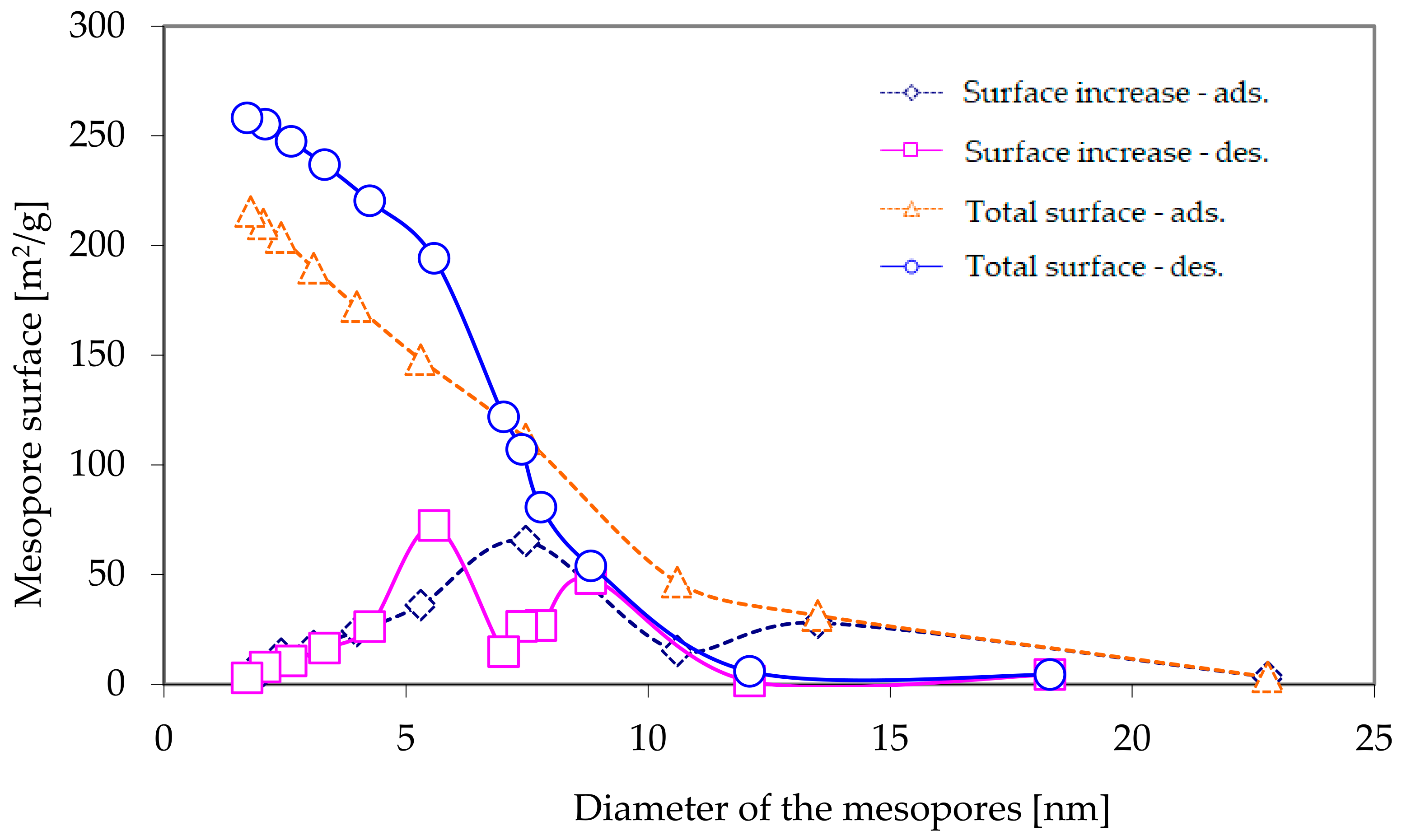
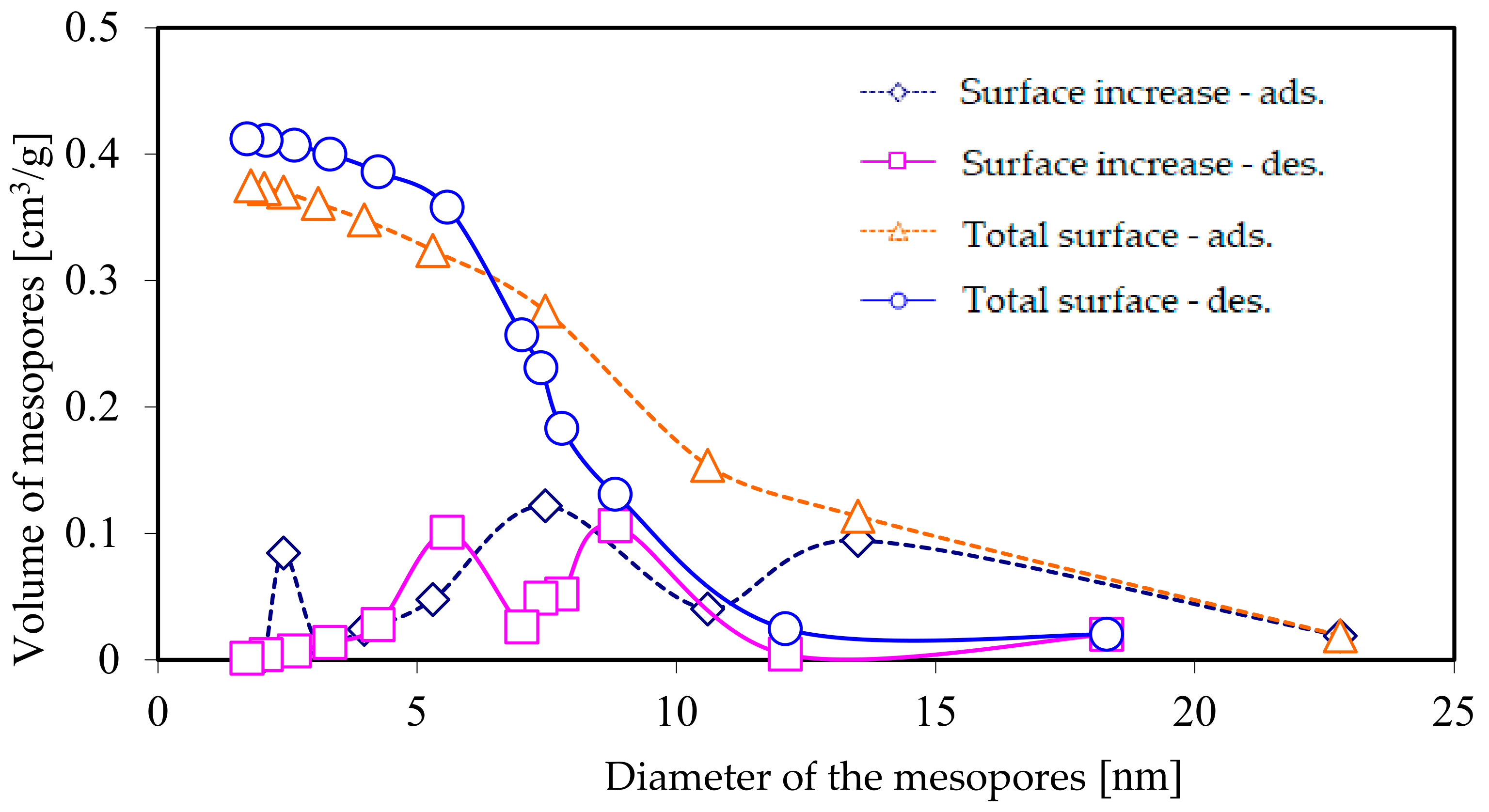


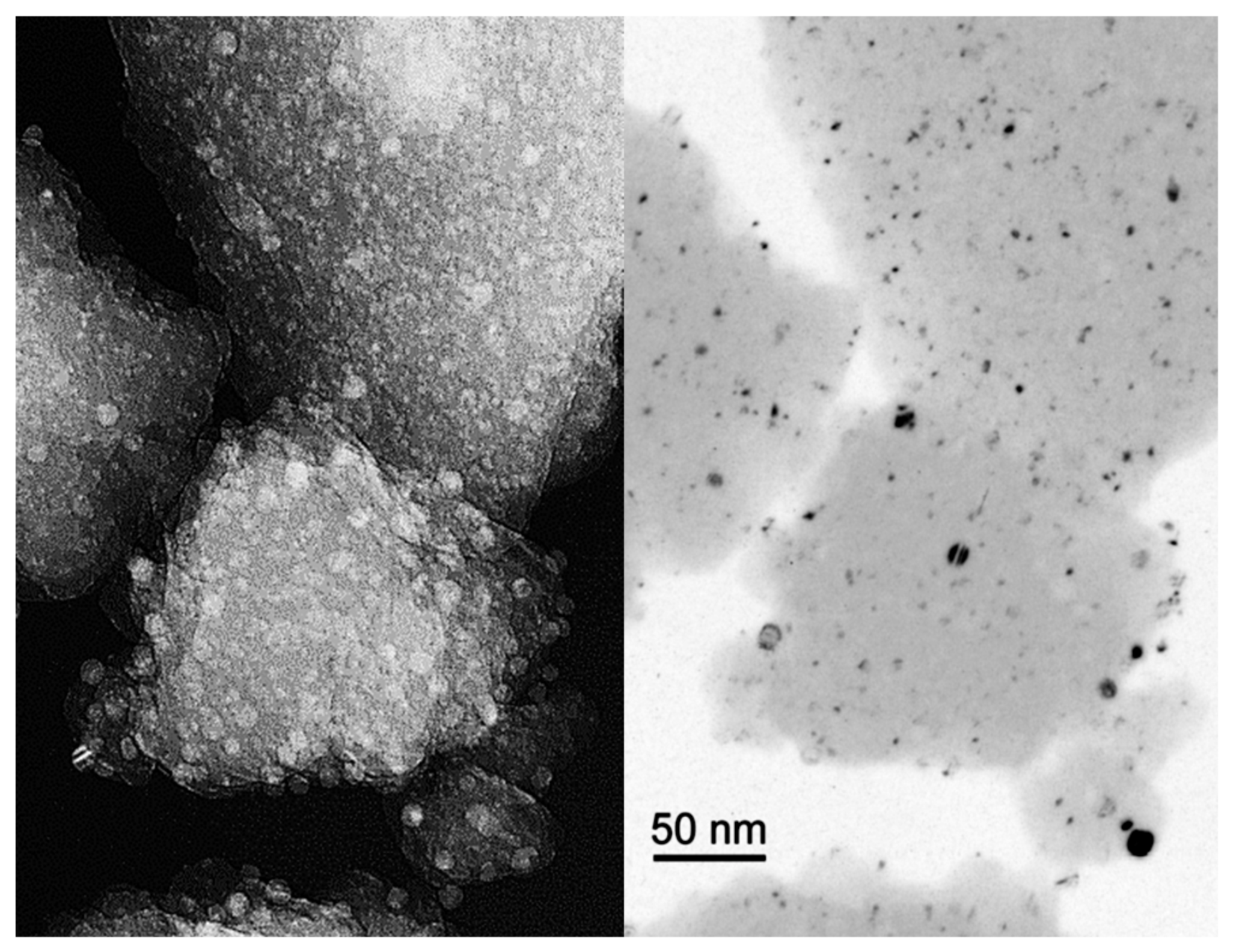

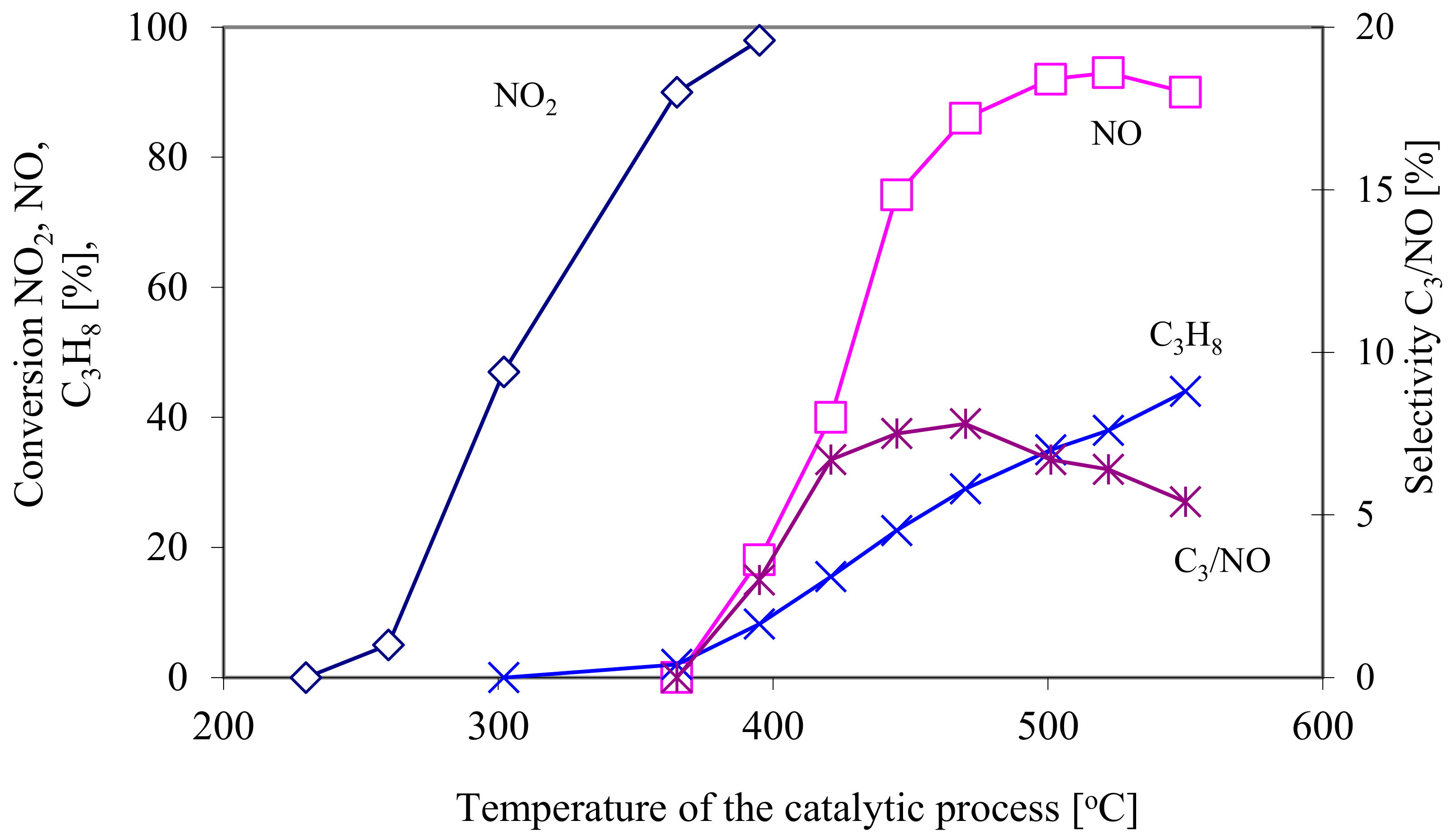
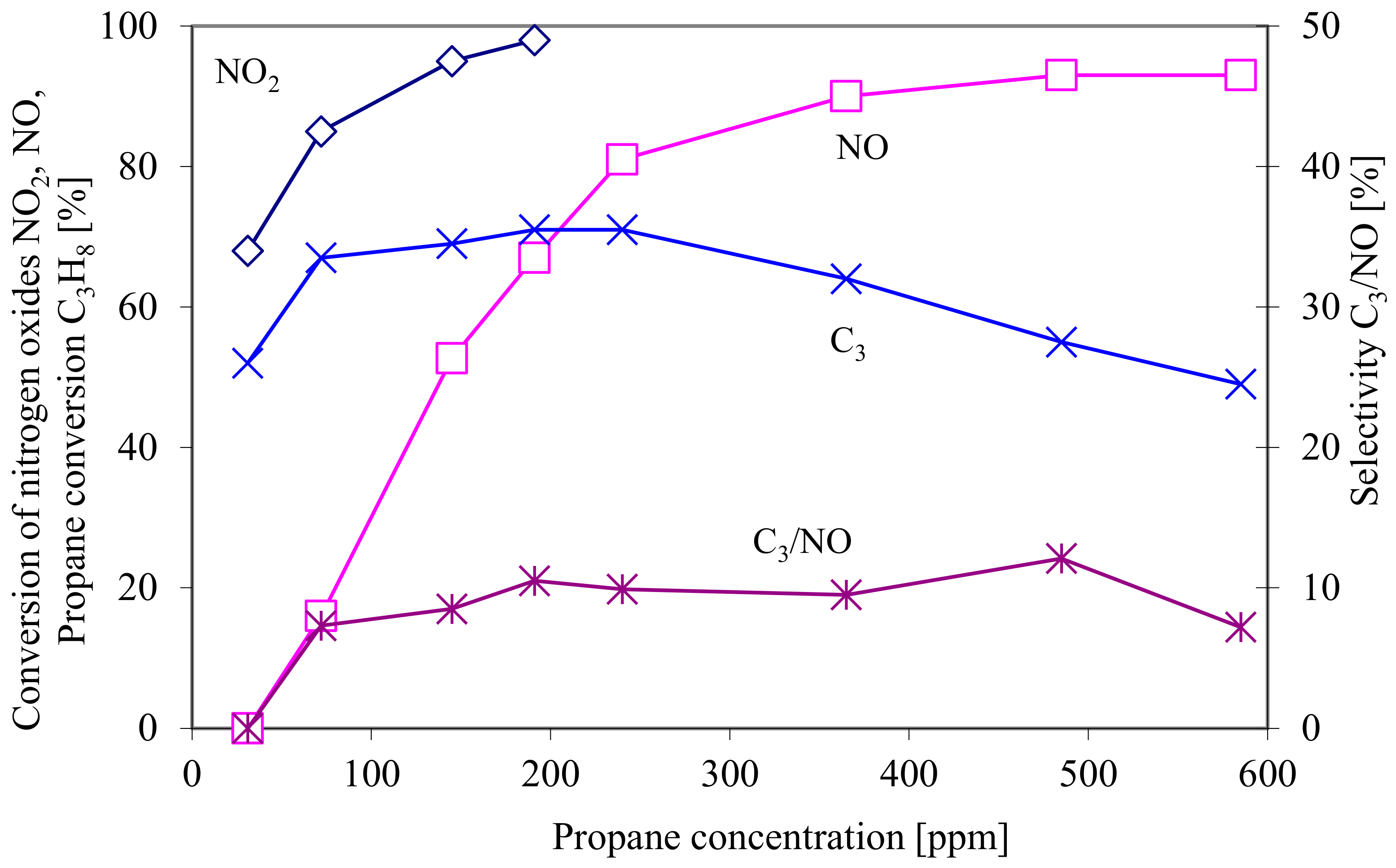
| NH3 Desorption Temperature Range [K] | Dose of Ammonia [mmol NH3/g] | No. of Particles [NH3/g] | No. of Particles [NH3/cm2] | Surface of the Catalyst Coated with NH3 [%] |
|---|---|---|---|---|
| 372–692 K | 0.56 | 3.373 × 1020 | 1.449 × 1014 | 27.7 |
| 600–692 K | 0.28 | 1.687 × 1020 | 0.7245 × 1014 | 13.85 |
Publisher’s Note: MDPI stays neutral with regard to jurisdictional claims in published maps and institutional affiliations. |
© 2020 by the authors. Licensee MDPI, Basel, Switzerland. This article is an open access article distributed under the terms and conditions of the Creative Commons Attribution (CC BY) license (http://creativecommons.org/licenses/by/4.0/).
Share and Cite
Kruczyński, S.W.; Orliński, P.; Ślęzak, M. NOx Reduction in Ag/Al2O3-SiO2 Converters in the Exhaust of a Compression-Ignition Engine. Energies 2021, 14, 20. https://doi.org/10.3390/en14010020
Kruczyński SW, Orliński P, Ślęzak M. NOx Reduction in Ag/Al2O3-SiO2 Converters in the Exhaust of a Compression-Ignition Engine. Energies. 2021; 14(1):20. https://doi.org/10.3390/en14010020
Chicago/Turabian StyleKruczyński, Stanisław W., Piotr Orliński, and Marcin Ślęzak. 2021. "NOx Reduction in Ag/Al2O3-SiO2 Converters in the Exhaust of a Compression-Ignition Engine" Energies 14, no. 1: 20. https://doi.org/10.3390/en14010020
APA StyleKruczyński, S. W., Orliński, P., & Ślęzak, M. (2021). NOx Reduction in Ag/Al2O3-SiO2 Converters in the Exhaust of a Compression-Ignition Engine. Energies, 14(1), 20. https://doi.org/10.3390/en14010020






